Virginia’s “New” Fishery
Dr. Ken Neill, III
published in The Fisherman
Offshore bottom fishing out of Virginia has greatly increased in popularity in recent years. Excitement about this fishery grew even more when six blueline tilefish and two snowy grouper IGFA All-Tackle World Records were set off the coast of Virginia over the past year. Four of those records were set on my boat, the Healthy Grin.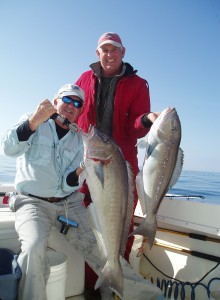
Of course, this is not really a new fishery. These fish have always been there and there have been some anglers who have fished for them over the years. This new found popularity is due to a number of events. Virginia has a very good offshore fishery during the summer except for one summer several years ago. The water was cold and the pelagic species we normally catch were just not there in any numbers. Charter captains needed to do something for their clients so they would take a break from trolling and drop some baits down to the bottom. They brought sea bass and blueline tilefish back to the dock to fill out the light tuna and dolphin catches. By that fall, the offshore currents were back to normal and we had a great fall season for tuna, dolphin and billfish. The tilefish were pretty much left alone after that. Sea bass have always been an important recreational catch but we did not run out that far to get them. They were caught closer to shore spring through fall. The offshore wrecks were mostly the domain of commercial fishermen. Those guys knew that the winter months were when these deep-water wrecks were loaded with jumbo sea bass. The recreational fleet knew something of this but we just did not run offshore out of Virginia during the wintertime. That was about to change.
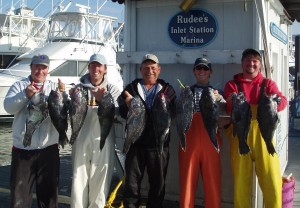 Virginia’s recreational fishery was primarily a spring-fall fishery. Everyone would winterize their boats and the marinas and tackle stores would go into their winter hibernation. There were a few guys who would fish for tautog all winter long but even that fishery was mostly a spring and fall event. Then the striped bass came back. This changed everything. Marinas, boat ramps, and tackle stores are no longer sleepy places in the winter. There are thousands of anglers who now fish all winter just because of these fish. What a boost for the local economies! This led to more anglers wreck fishing for tautog to add some variety to their wintertime fishing. Taking advantage of this pool of active fishermen, headboats started to run some trips out to the deepwater wrecks for sea bass. This was a real eye-opener. A single headboat trip would come back in with more sea bass weighing in at over five pounds than the entire recreational fleet had caught over the rest of the year. These trips became very popular and remain so today. More private boats and 6-pack charters started to run out and fish these wrecks also. The sea bass were huge. The current world record is a 10 pound 4 ounce monster caught off of Virginia by Allan Paschall during the winter of 2000. We had another reason to keep fishing all year. Well, you run offshore to a wreck that is loaded with big sea bass and you catch your limit in short order. Now you have a choice to make, run home or fish for something else.
Virginia’s recreational fishery was primarily a spring-fall fishery. Everyone would winterize their boats and the marinas and tackle stores would go into their winter hibernation. There were a few guys who would fish for tautog all winter long but even that fishery was mostly a spring and fall event. Then the striped bass came back. This changed everything. Marinas, boat ramps, and tackle stores are no longer sleepy places in the winter. There are thousands of anglers who now fish all winter just because of these fish. What a boost for the local economies! This led to more anglers wreck fishing for tautog to add some variety to their wintertime fishing. Taking advantage of this pool of active fishermen, headboats started to run some trips out to the deepwater wrecks for sea bass. This was a real eye-opener. A single headboat trip would come back in with more sea bass weighing in at over five pounds than the entire recreational fleet had caught over the rest of the year. These trips became very popular and remain so today. More private boats and 6-pack charters started to run out and fish these wrecks also. The sea bass were huge. The current world record is a 10 pound 4 ounce monster caught off of Virginia by Allan Paschall during the winter of 2000. We had another reason to keep fishing all year. Well, you run offshore to a wreck that is loaded with big sea bass and you catch your limit in short order. Now you have a choice to make, run home or fish for something else.
The something else turned out to be blueline tilefish and the records began to fall. And they kept falling. With more anglers fishing out there, we started to catch some other fish like wreckfish, yellowedge grouper, and snowy grouper. More records were broken. In addition to the sea bass world record, Virginia now holds the world record 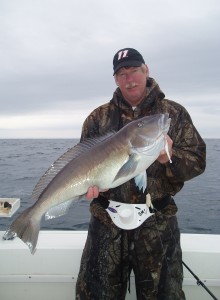 for blueline tilefish and snowy grouper…several times over. The current world record blueline tilefish is a 17 pound 7 ounce fish caught by Jenny Manus, July 15, 2006. The current world record snowy grouper is a 37 pound 9 ounce fish caught by Jason Ferguson, July 10, 2006. As you can see, what started out as primarily a winter fishery has become one which is now practiced all year long.
for blueline tilefish and snowy grouper…several times over. The current world record blueline tilefish is a 17 pound 7 ounce fish caught by Jenny Manus, July 15, 2006. The current world record snowy grouper is a 37 pound 9 ounce fish caught by Jason Ferguson, July 10, 2006. As you can see, what started out as primarily a winter fishery has become one which is now practiced all year long.
Now, about these records, bigger fish are out there and bigger ones have been caught either by commercial fishermen or by recreational anglers using electric reels. This disqualifies them from IGFA record consideration. Another thing that will disqualify many of these fish is the number of hooks that you are using. When you are dropping that far down, you want to catch something. It is a long way up just to check your bait so it is not unusual to fish with 3 to 5 baited hooks. For record consideration, the IGFA only allows you to use 2 hooks. Due to the growing popularity of this fishery, Virginia has added snowy grouper, blueline tilefish and golden tilefish as eligible species for state records. We also added blueline tilefish to the trophy fish citation program. It takes a ten pound blueline to qualify for a citation. Virginia does not limit the number of hooks used but electric reels are not allowed to be used for the citation or state record programs.
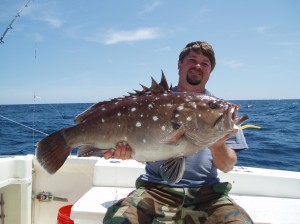 OK, the offshore waters off of Virginia are a good place to catch bottom fish. How to start? Well, the best way to shorten the learning curve is to go with a pro. There are several types of charters to choose from. You can choose a big headboat which is the most economical way to go. They have large cabins for your ride out and back. They are slow making for a long ride. They also carry a lot of people which means that you can expect a lot of tangles. For more personal service, you can go on a small headboat. Fewer passengers mean fewer tangles. These trips will cost you a little more. The next type of trip would be the typical 6-pack charter. These boats are fast making for less time running. Pick the size crowd that you want to fish with. They all provide a great service, you will catch fish and you will learn something to boot.
OK, the offshore waters off of Virginia are a good place to catch bottom fish. How to start? Well, the best way to shorten the learning curve is to go with a pro. There are several types of charters to choose from. You can choose a big headboat which is the most economical way to go. They have large cabins for your ride out and back. They are slow making for a long ride. They also carry a lot of people which means that you can expect a lot of tangles. For more personal service, you can go on a small headboat. Fewer passengers mean fewer tangles. These trips will cost you a little more. The next type of trip would be the typical 6-pack charter. These boats are fast making for less time running. Pick the size crowd that you want to fish with. They all provide a great service, you will catch fish and you will learn something to boot.
When you want to head out in your own boat, it is a big ocean out there. Let’s narrow it down a bit. Any structure out there will hold sea bass. The deepwater wrecks will have them all year but it is the cold time of year when the jumbo sea bass are stacked up. Look for wrecks laying in twenty to fifty fathoms of water. Some good sea bass wrecks are the Ocean Venture, the 44-Fathom Wreck, and the Chenango. Wreckfish are called wreckfish because that is where you catch them. You will catch some tilefish around the wrecks but that is not where most of them are being caught. Off of Virginia, the 50 fathom curve seems to be the magic area for blueline tilefish. Watch your bottom machine while traveling in water 45 to 55 fathoms deep. Stop and fish anything that looks different. Sometimes you will see a cloud of fish but often it will just be a small hill or a dip in the bottom. Try it and if you catch a tilefish, save that mark. These fish live in colonies. We have caught tilefish all along the 50 fathom curve from east of the Cigar on up past the Norfolk Canyon. Tilefish and grouper will be out there all year. We have been catching the grouper in the same areas that we have found the tilefish, maybe just a little deeper. You will catch a lot more tilefish than grouper. Sea bass will also be mixed in with the tilefish and grouper.
out there will hold sea bass. The deepwater wrecks will have them all year but it is the cold time of year when the jumbo sea bass are stacked up. Look for wrecks laying in twenty to fifty fathoms of water. Some good sea bass wrecks are the Ocean Venture, the 44-Fathom Wreck, and the Chenango. Wreckfish are called wreckfish because that is where you catch them. You will catch some tilefish around the wrecks but that is not where most of them are being caught. Off of Virginia, the 50 fathom curve seems to be the magic area for blueline tilefish. Watch your bottom machine while traveling in water 45 to 55 fathoms deep. Stop and fish anything that looks different. Sometimes you will see a cloud of fish but often it will just be a small hill or a dip in the bottom. Try it and if you catch a tilefish, save that mark. These fish live in colonies. We have caught tilefish all along the 50 fathom curve from east of the Cigar on up past the Norfolk Canyon. Tilefish and grouper will be out there all year. We have been catching the grouper in the same areas that we have found the tilefish, maybe just a little deeper. You will catch a lot more tilefish than grouper. Sea bass will also be mixed in with the tilefish and grouper.
 You probably already have the tackle that you need for this type of fishing. Any medium-sized conventional reel will work with a rod with some backbone. Big and heavy offshore trolling tackle is not needed. What you are using to troll for striped bass will probably work just fine. Reels in the size of a Penn 320 or 330 will do the trick. If you are going to buy a new reel for this type of fishing, pick one that is not too heavy, has a large handle, and has a higher gear ratio. You will appreciate it when it is time to reel all that line back to the top. The Shimano Torium is a popular choice. It can even be done with a spinning reel. Bob Manus brought one out and used it to catch tilefish just to see if it could be done. It can. We will talk a bit more about Bob in a moment. Of course, if you would like to catch these bottom fish with less effort and you don’t care about records, this is what electric reels are made for. Whatever reel you use, it should be spooled up with some sort of braided line. It can be done with monofilament but the braid will let you feel what is going on much more easily.
You probably already have the tackle that you need for this type of fishing. Any medium-sized conventional reel will work with a rod with some backbone. Big and heavy offshore trolling tackle is not needed. What you are using to troll for striped bass will probably work just fine. Reels in the size of a Penn 320 or 330 will do the trick. If you are going to buy a new reel for this type of fishing, pick one that is not too heavy, has a large handle, and has a higher gear ratio. You will appreciate it when it is time to reel all that line back to the top. The Shimano Torium is a popular choice. It can even be done with a spinning reel. Bob Manus brought one out and used it to catch tilefish just to see if it could be done. It can. We will talk a bit more about Bob in a moment. Of course, if you would like to catch these bottom fish with less effort and you don’t care about records, this is what electric reels are made for. Whatever reel you use, it should be spooled up with some sort of braided line. It can be done with monofilament but the braid will let you feel what is going on much more easily.
Terminal tackle is simple and you can tie your own. One rig is made with 50 lb monofilament leader. Tie a loop in each in with a couple of dropper loops in the middle. Place a couple of hooks on your dropper loops. Attach a sinker to one end and attach the other end to your main line. Hooks can be j-hooks or circle hooks. We use both. This is our typical sea bass rig which can be used for all of the bottom fish out there. When we are targeting grouper, we will beef things up a bit with 100 lb leader. We will basically fish with a hefty flounder rig, a three-way swivel with a short dropper to the sinker and a three to five foot dropper to our hook. A third rig we will use is pretty much in-between these two. 80-100 pound leader with a loop at each end to attach a sinker and your main line. Instead of dropper loops, we use two three-way swivels to attach our hooks to. We use about 12 inches of leader between the 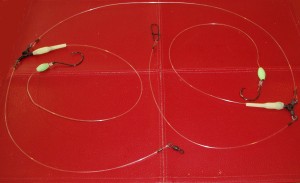 hooks and swivels. Jeff Dail likes to add glow beads to this rig to spice things up. You will need to use a heavy enough sinker to stay on the bottom. This can range anywhere from eight to thirty-two ounces of lead.
hooks and swivels. Jeff Dail likes to add glow beads to this rig to spice things up. You will need to use a heavy enough sinker to stay on the bottom. This can range anywhere from eight to thirty-two ounces of lead.
Bait can be just about anything you can think of. Sea bass, tilefish, and wreckfish seem to eat anything. Squid, clam, and any cut fish work fine. Boston mackerel stays on the hook well and makes a good cut bait. The grouper we have caught have all been caught on fish baits so far. Artificial baits will work. Heavy jigs like diamond jigs have long been used to catch big sea bass. They also work on tilefish. That is what Bob Manus was doing out there with a spinning rod, he was catching tilefish with a diamond jig. The artificial “natural” baits like Gulp will also work but that brings us back to Bob again. Bob had the idea of making his own bait. He thought that a piece of natural sponge soaked in menhaden oil might make a good bait and stay on the hook well. He could not find a natural sponge so he bought a big, yellow artificial sponge like you might use while washing your car. He showed up at the boat with the sponge cut up into cubes. So we have a guy named Bob with a bunch of little yellow sponges. He put one on each hook, dipped them into the oil and started catching monster sea bass two at a time. He weighed-in 5 citations that day. On later trips, he tried the 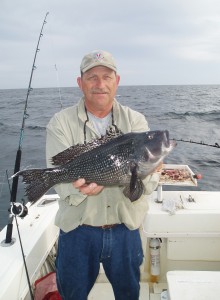 sponge without the oil and still caught fish just as fast as the rest of us using natural bait. Sea bass, blueline tilefish and wreckfish all love the sponge. Bob is now known as Sponge Bob wherever he goes. We tease him about it but whenever we head offshore, we make sure that he has his bag of sponges with him.
sponge without the oil and still caught fish just as fast as the rest of us using natural bait. Sea bass, blueline tilefish and wreckfish all love the sponge. Bob is now known as Sponge Bob wherever he goes. We tease him about it but whenever we head offshore, we make sure that he has his bag of sponges with him.
This “new” fishery has raised some regulatory concerns. These fish are considered over-fished in areas to our south while we seem to have very healthy populations here. These fish are regulated by the regional management councils. We are not really supposed to have these fish so off of Virginia, except for sea bass, we are totally unregulated at the time this is written. Areas to our south have very strict regulations. Right now the regional councils are looking at extending the southern regulations north to try and protect this fishery. These regulations are very complex and would lead to some interesting conflicts. Wreckfish are mostly a recreational catch here while in the southern region they are regulated as a commercial only species. Virginia is looking at enacting its own regulations to sustain this fantastic fishery which we have off of our coast. We probably do need some regulations put on this deep-water fishery but the draconian regulations to the south are probably more than we need. Right now, you can keep 25 sea bass at least 12 inches long per person. Before you head out there, check the latest regulations. I expect Virginia may have some regulations for tilefish, grouper, and wreckfish in place before the end of the year.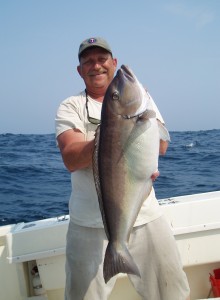
Offshore Wrecks
Ocean Venture: 37 04.425′
074 55.722′
44 Fathom: 36 54.775′
074 42.456′
Chenango: 36 27.617′
074 56.601′
Charters
Capt. Joe DelCampo (757) 639-8363
Capt. David Wright (757) 430-1305
Capt. Jim Brincefield (252) 336-4296
